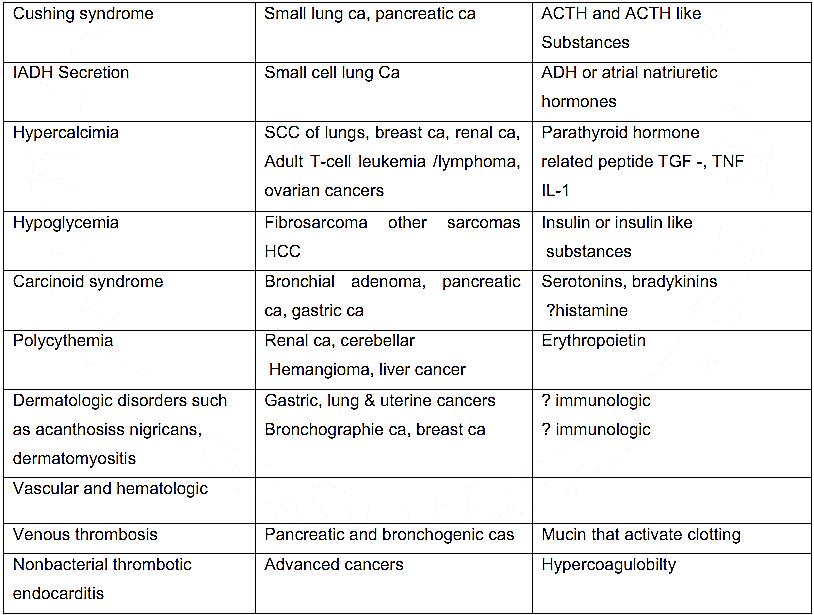
Clinical Features of Tumors
 المؤلف:
Bezabeh ,M. ; Tesfaye,A.; Ergicho, B.; Erke, M.; Mengistu, S. ; Bedane,A. and Desta, A
المؤلف:
Bezabeh ,M. ; Tesfaye,A.; Ergicho, B.; Erke, M.; Mengistu, S. ; Bedane,A. and Desta, A
 المصدر:
General Pathology
المصدر:
General Pathology
 الجزء والصفحة:
الجزء والصفحة:
 19-2-2016
19-2-2016
 3050
3050
Clinical Features of Tumors
Neoplasms are essentially parasites. In fact, benign lesions are more common than cancers. Although cancer evaluation may suggest one or the other, the only unequivocal benign mass is the excised and histopathological diagnosed one.
Effects of tumour on the host:
Both benigin and malignant neoplasms may cause problems because of
1. location and impingement on adjacent structures
2. functional activities such as hormone synthesis
3. bleeding and secondary infection when they ulcerate through adjacent natural surfaces
4. initiation of acute symptoms caused by either rupture or infarction local and hormonal effects
- For example pituitary adenoma being located in critical location can cause serious endocrinopathies
- Analogously cancers arising with or metastatic to an endocrine organ may cause an endocrine in sufficiency by destroying the gland.
- Neoplasms in the gut (both bening and malignant may cause obstruction as they enlarge
- Benign neoplasms more commonly of endocrine origin may produce manifestations by elaboration of hormones. For example a benign B- cell adenoma of pancreatic islets less than 1 cm in diameter may produce sufficient insulin to cause fatal hypoglycemia
- The erosive destructive growth of cancers or expansile pressure on benign tumour of any natural surface may cause ulceration secondary infection and bleeding.
5. Cancer cachexia
- Cachexia is a progressive loss of body fat and lean body mass accompanied by profound weakness, anorexia and anemia .The origin of cancer cachexia are obscure
- Clinically anorexia is a common problem in patients with cancer. Reduced food intake has been related to abnormalities in taste and central control of appetite. In patents with cancer, calorie expenditure often remains high and basal metabolic rate is increased despite reduced food intake.
- The basis of metabolic abnormalities is not fully understood; however, TNF produced by macrophages and possibly by some tumour cells is the mediator of the wasting syndrome that accompanies cancer. Other cytokines such as IL-1 and IFN α synergize with TNFα –
- A protein-mobilizing factor has been isolated from the serum of animals and humans with cancer cachexia
6. Paraneoplastic syndromes
- Paraneoplastic syndrome is an aggregate of symptom complexes in cancer - bearing patients that cannot readily be explained either by the local or distant spread of the tumour or by the elaboration of hormones indigenous to the tissue from which the tumour arose
- Paraneoplastic syndrome occurs in about 10% of patients with malignant disease
- Despite its infrequency, the syndrome is important for three reasons:
1. They be the earliest manifestation of an occult neoplasm
2. In affected patients, they may represent significant clinical problems and may even be lethal.
3. They may mimic metastatic disease and, therefore, confound treatment
Classification of paraneoplastic syndromes

Hypercalcemia is probably the most common paraneoplastic syndrome and among endocrinopathies Cushing syndrome is the most common variety of paraneoplastic effect.
Grading and staging of cancers
- Grading denotes the level of differentiation whereas, staging expresses the extent of tumour spread and forcast the clinical gravity of cancers
- Grading of a cancer is based on the degree of differentiation of tumour cells and the number of mitoses within the tumour and presumably correlates to aggressive character of the neoplasm
- Cancers are classified into grades I to IV with increasing anaplasia. Criteria for individual grades vary with each form of neoplasm
- The staging of cancers is based on the size of primary lesions, its extent of spread to regional lymph nodes and the presence or absence of blood born metastases
- Two major staging systems are currently in use are Union internationale center cancer (UICC) which utilizes the so- called TNM system T for primary tumour N for regional lymph node involvement and m for metastasis .
The TNM staging varies for each specific form of cancer but there are general principles:
- With increasing size, the primary lesion is characterized as T to T4 to is added to indicate as in - situ lesion.
- No for no nodal involvement whereas, N1 -N3 wound denote involvement of an increasing number and range of nodes
- Mo signifies no distant metastasis whereas M1 or sometimes M2 indicates the presence of blood born metastasis
The American joint committee (AJC) employs a somewhat different nomenclature and divides all cancers into stages to IV incorporating within each of these stages the size of the primary lesion as well as the presence of nodal spread and the distant metastasis
- The staging of neoplastic disease has assumed great importance in the selection of the best form of therapy for the patient. Indeed, staging has proved to be of greater clinical value than grading.
References
Bezabeh ,M. ; Tesfaye,A.; Ergicho, B.; Erke, M.; Mengistu, S. and Bedane,A.; Desta, A.(2004). General Pathology. Jimma University, Gondar University Haramaya University, Dedub University.
 الاكثر قراءة في الاورام
الاكثر قراءة في الاورام
 اخر الاخبار
اخر الاخبار
اخبار العتبة العباسية المقدسة


